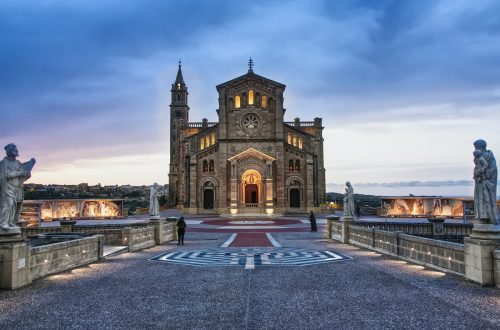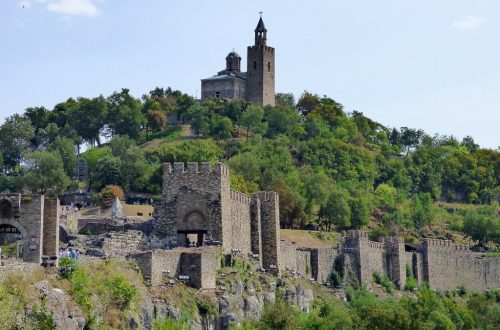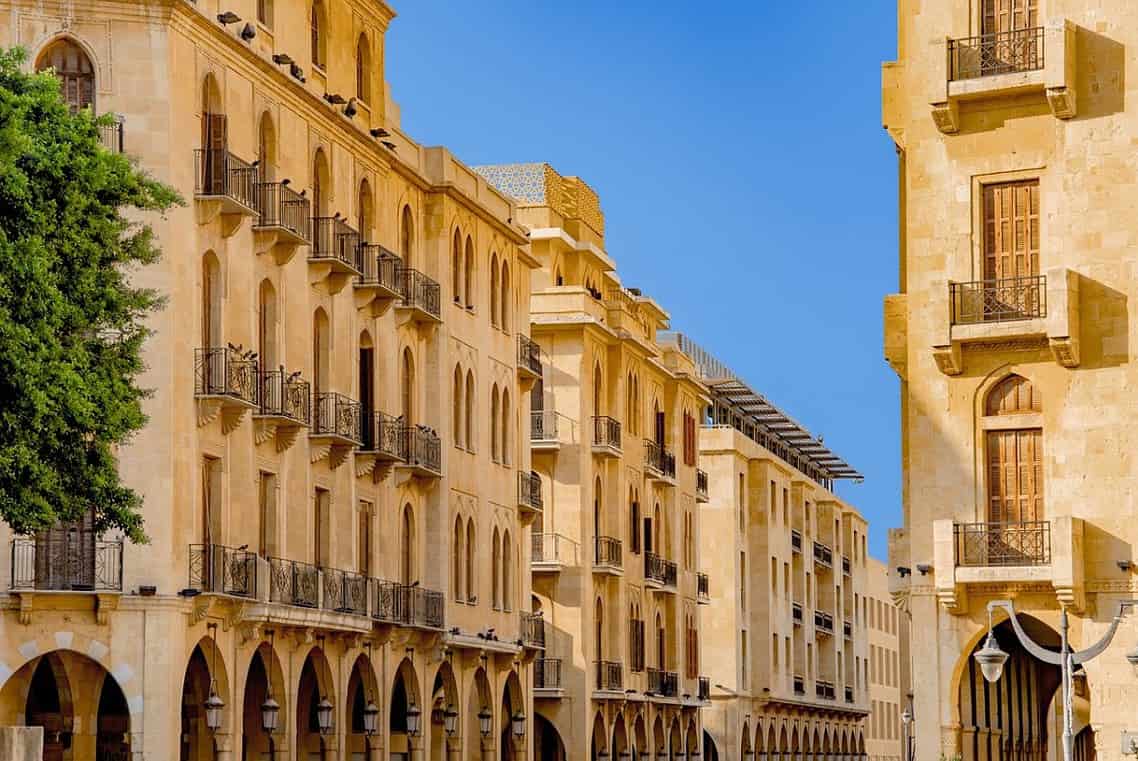
The BEST Travel Guide for Beirut, Lebanon
Intriguing, welcoming, and steeped in history and struggle, Beirut is a city that invites travelers to explore its charm. With its rich history, bustling markets, and a vibrant street life, it’s a destination where the old and new coexist seamlessly. In the Best Travel Guide for Beirut, you will find everything you need to know before you travel to a city of contradictions, trying to rebuild itself.
The Best Travel Guide for Beirut
A Little Bit of History
Beirut’s history dates thousands of years back. It started as the Phoenician city of Berytus, then saw the rule of Romans, Byzantines, Arabs, Crusaders, and more. In the 20th century, it gained independence and became a thriving hub.
Despite enduring the Lebanese Civil War, Beirut remains a symbol of strength and recovery, blending its rich past with its lively present.
Is it Safe to Travel to Beirut?
There has been a lot of debate lately on whether Beirut and Lebanon, in general, are safe.
One of the first things that has to come to your mind when planning a trip is insurance.
Safetywing’s Nomad Insurance is one of the best options available out there. With a maximum coverage of 365 days, they are a great option whether you are a Nomad or not! They offer very low rates, but excellent coverage and immediate support (in a few minutes!). The best part? Nomad Insurance can be purchased even if you have left your home country already.
Lastly, they also cover extreme sports, something that can come in very handy if you are an adventurous soul.
It is true that there has been some political instability in the country in the past few years. The Lebanese economy has crashed, causing massive inflation and political unrest. There have been massive protests against the government’s policies. However, this has nothing to do with the safety of a tourist.
The people’s anger is towards the political system rather than a foreigner who wants to discover this beautiful country and meet its amazing and hospitable people. Beirut is one of the safest cities in the Middle East, and it has remained so despite recent events. I can indeed say that in Beirut, I felt as safe as I would feel anywhere else (Even in Europe!).
Obviously, like everywhere else in the world, you should constantly be updated on the latest developments and take basic safety precautions. But, yes, you can safely travel to Beirut.
What is the best time of year to visit Beirut?
Although Beirut is a city that offers you a unique experience no matter the time of year, the best time to visit largely depends on your personal preferences and interests. Between April and June, you’ll encounter spring temperatures, fewer crowds, and a city awakening from its winter slumber. The weather is mild and enjoyable, and the city is beautifully adorned with blossoming flowers.
Summer, from July to September, is the peak tourist season. The city buzzes with activity as it hosts a variety of festivals, concerts, and outdoor events. However, it can get quite hot, and the beaches and streets can be crowded.
Fall, which stretches from October to November, brings milder heat and an easing of crowds. This is a great time to explore the city at your own pace. During December to March, winter sets in. Although temperatures drop, Beirut’s winter is still relatively mild and the city’s charms continue to shine.
How to Get to Beirut
It is actually very easy to travel to Beirut. The primary way to get there is through the Beirut National Airport. You’ll find direct flights from most European (and not only) cities. The airport is small and can get really crowded.
Furthermore, there are frequent power cuts, so make sure to arrive a few hours before your flight. Better safe than sorry!
What Currency Should you Use in Beirut?
Money is quite a complex issue in Lebanon and it can be a big struggle when you travel to Beirut. As I wrote above, the country is suffering from massive inflation. The Lebanese Lira has lost more than 90% (!) of its value, which continues to fall daily. The worst thing, though, is that it is almost impossible to regain it. All the above have had two significant effects on the country.
First of all, the United States dollar has also been adopted as an alternative currency. It has come to the point that the USD is even more widely used than the Lebanese Lera. You’ll see that the prices are written in both currencies almost everywhere (except for official government-owned services). At some places, you’ll then see the prices only in dollars!
Secondly, Lebanon (and thus Beirut) is a primarily cash-driven economy. Credit cards are not widely accepted due to the current economic situation. Only some major hotels and restaurants are accepting card payments.
Now, let’s dive into money exchange. You can exchange your cash (preferably dollars as they have a better rate) for Lebanese Lira in official exchange offices or the “infamous” black market. But what do we mean when we are talking about the black market?
The black market in Lebanon is essentially everywhere. It is not a spooky mafia-type person who will exchange money with you in a dark alley. Most places, from hotels to stores, restaurants, or even individuals, will offer you their exchange rate, which may be a bit better than the official one. They do this because the dollar is more stable, and prefer keeping their savings in USD.
So, having all these things in mind, what should you do?
I suggest that you have your cash in USD when you travel to Beirut. Everyone basically accepts the currency, and your money will now lose its value while you are there. Even if USD is not your country’s currency, I’d say you exchange it before coming to Lebanon.
This, however, comes with a major drawback. If you don’t have the exact amount you need, you’ll get your change in Lira at a rate, the shop/restaurant, etc., feels like exchanging. To combat that, you have your dollars in smaller bills so that you’ll always be able to have the exact amount you need. This way, you’ll ensure you are not losing money in every transaction.
If you want to escape the hassle, you can always exchange your money in one of the many exchange stores around the city.
Whatever option you choose, make sure you have more than the estimated amount of money for your trip in cash beforehand, as ATMs will either not be working or have a very low withdrawal limit.
Is Beirut Expensive?
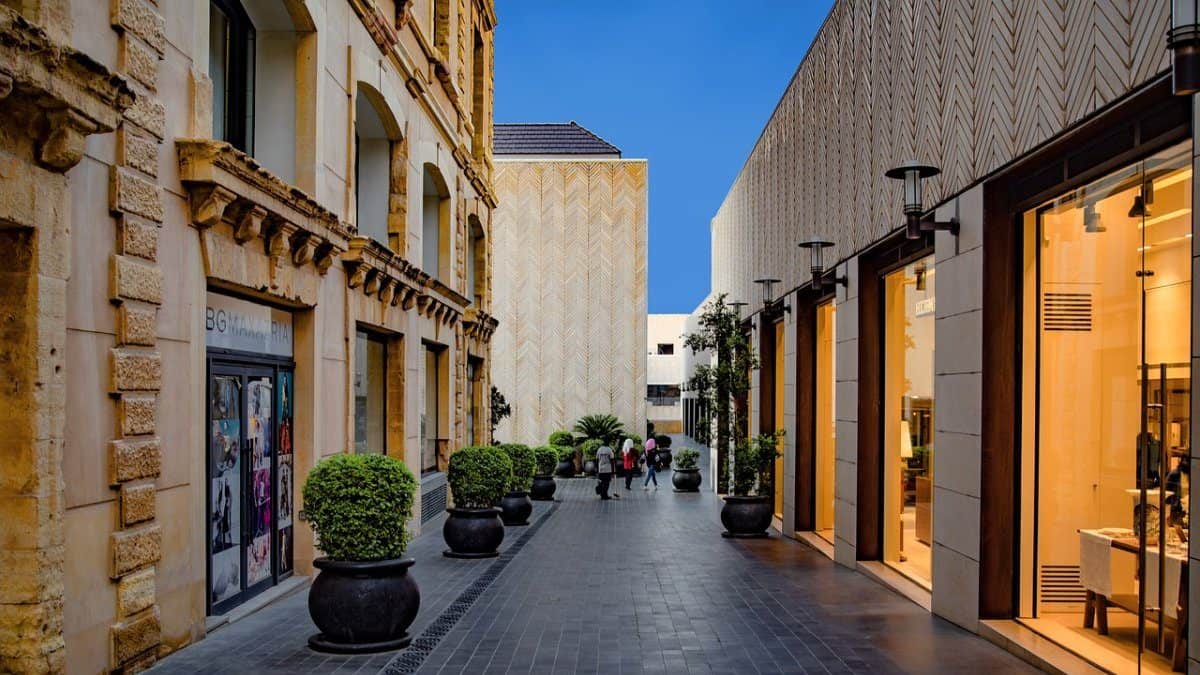
This may come as a surprise, but Beirut is an expensive city to travel to. The cheapest hotel we could find was $ 65 per night, while a restaurant meal (main dish, drink, and dessert) will set you back around $ 20.
Budget options can surely be found, but this doesn’t change the fact that Lebanon is one of the most expensive countries in the Middle East.
Getting a Sim Card in Beirut
Getting a SIM card in Lebanon is easy, but expensive. You’ll find cards from the two best companies, Alfa and Touch, in many places around the city.
However, the card itself is not so budget-friendly. For a SIM card with 10GB of data, you’ll be spending around 40$ at best. Some places will give you $5-10 refund if you return the card after you use it.
I don’t know if there is some chip shortage, but I was really surprised with what I saw. You’ll be able to get data from an online app, but the employees at the store will explain everything to you when you travel to Beirut.
I’d recommend you check out a few places before buying, in case you get a better price. If you find a package of around $30-35, you should get it. It’s a good deal.
Getting Around in Beirut
Getting around when you travel to Beirut is not the easiest of tasks, but because this is the Best Travel Guide for Beirut, I’ll try to explain it as best as I can.
The city has no public transportation system, which can be a huge problem. The most convenient way to move around is by renting a car. However, if that is not an option, using taxis would be your best choice. There are two types of taxis in Beirut.
First, there are the “normal” taxis you’ll find everywhere. My advice would be to try to negotiate, which can be very helpful in getting the price down. You can always use Uber, as the rates can be slightly better.
Then, there are the shared taxis, called “services,” that will ask you about your destination and, if it fits their course, will take you for a smaller fee. Be prepared for many rejections, though!
Where to Stay in Beirut
There are many great hotel options to choose from when you travel to Beirut. While there are few budget-friendly places, finding a hotel at around 60-70$/night will be easy.
We stayed at the Orient Queen Homes hotel. Their facilities were excellent, the staff fantastic, and the placement of the hotel was central and near the Corniche.
Is Tap Water in Beirut Drinkable?
Tap water in Beirut is not drinkable! Make sure to get water bottles from a supermarket when you travel to Beirut, as you most probably don’t want to get sick!
What About Food in Beirut?

Lebanese food is a delightful journey for your taste buds. It is actually considered to be one of the best cuisines in the world!
From creamy hummus and crispy falafel to flavorful shawarmas and fresh tabbouleh, be prepared with a tasty blend of Mediterranean and Middle Eastern flavors.
If you are a meat-eater, take advantage of the grilled kebabs with their aromatic spices! And if you’re a vegetarian or a fan of grilled vegetables, the mezze selection is a dream come true, with offerings like stuffed grape leaves and fried cauliflower.
As the trip to Lebanon was part of our journey to Syria, we didn’t have time to explore all the food options the city of Beirut has to offer. However, I have a food recommendation to make.
Mohammad Sahyoun is known to have the best falafel shawarma in Beirut! It is a small place located near the Blue Mosque. I can safely say that it leaves up to the hype.
It was the best falafel I’ve ever had! Keep this place in mind when you travel to Beirut. When there, you’ll see two stores with the same name. This can be confusing, but the original is the one on the left!
The Best Things to Do in Beirut
It Wouldn’t be the Best Travel Guide for Beirut without the Best things to do there, would it?ithout further ado, let’s get into it!
1. Walk Along the Corniche
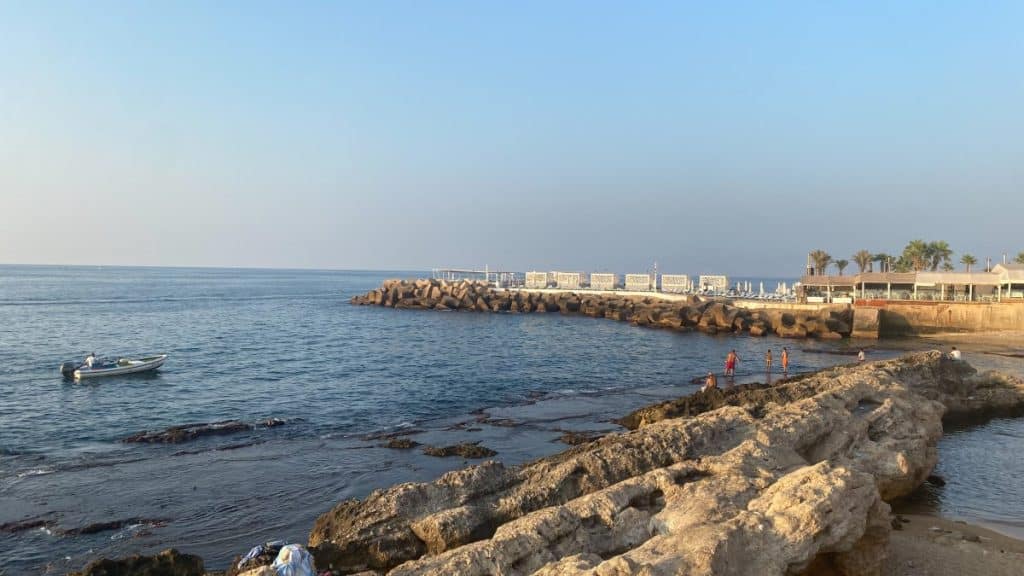
The Corniche is a beautiful seaside pavement walkway that stretches along Beirut’s Mediterranean coastline. It offers stunning views of the sea, the city, and the mountains. It makes a popular spot for jogging, walking, and enjoying the sunset for locals and tourists alike.
There are many restaurants and cafés along the way to enjoy some fantastic seafood lunch or an afternoon coffee and ice cream. If you are visiting in the summer, don’t forget to bring your swimsuit, as diving in the pristine Mediterranean waters is not to be missed when you travel to Beirut!
2. Admire the Pigeon Rocks
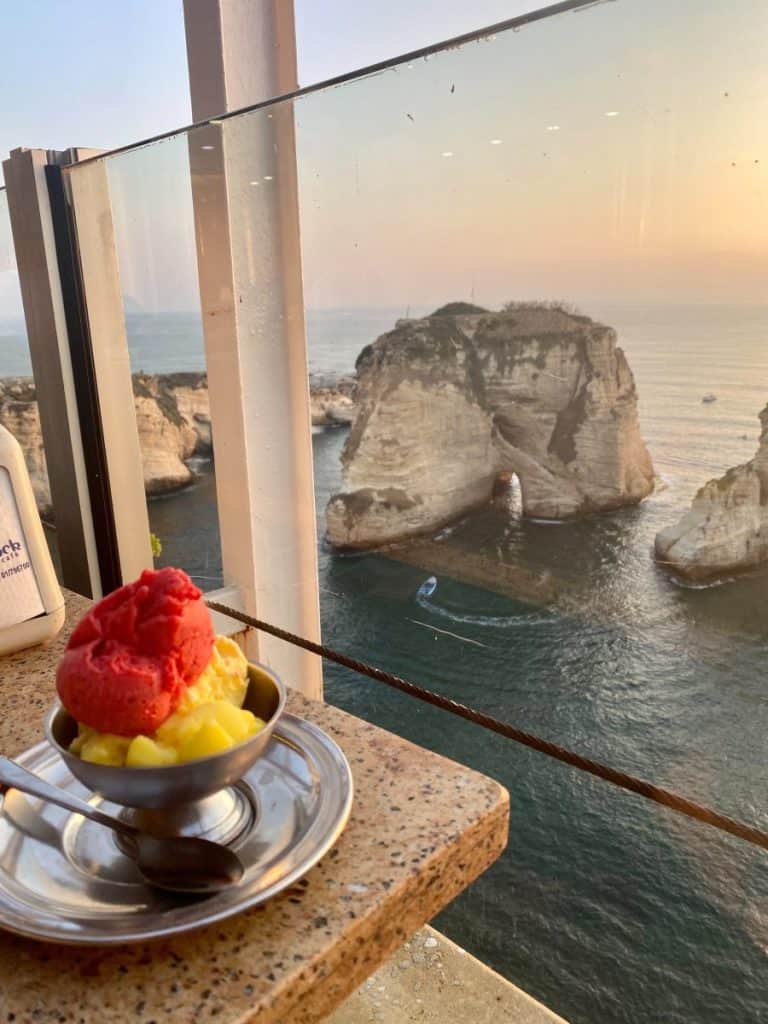
The Pigeon Rocks, also known as “Raouche Rocks,” are one of Beirut’s most iconic natural landmarks. They basically are two massive rock formations that rise from the Mediterranean Sea just off the end of the Corniche.
The rocks are composed of sedimentary rock, and their most distinctive feature is the numerous holes and cavities that have formed in them over the years. They were created over millions of years due to natural geological processes, and they got their name “Pigeon Rocks” because they serve as a nesting site for several species of seabirds, including pigeons.
There are also numerous cafes and restaurants along the coastline that offer stunning views of the Pigeon Rocks. The Bayrock café is a great place to relax, have a meal or an ice cream, and enjoy the majestic scenery.
3. Walk Around Hamra
Hamra is a lively neighborhood known for its bustling streets, shops, cafes, and nightlife. It’s a cultural and commercial center with a mix of modern and traditional influences. Take your time, walk around, and see what this lovely and lively neighborhood has to offer!
4. Visit the Roman Forum
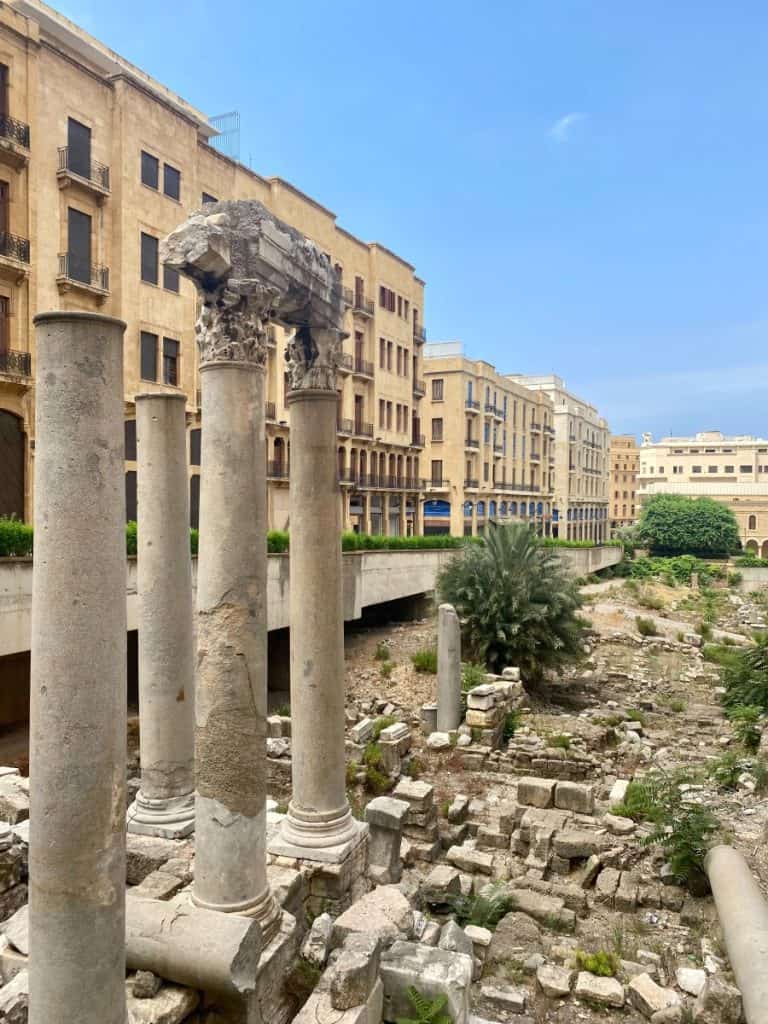
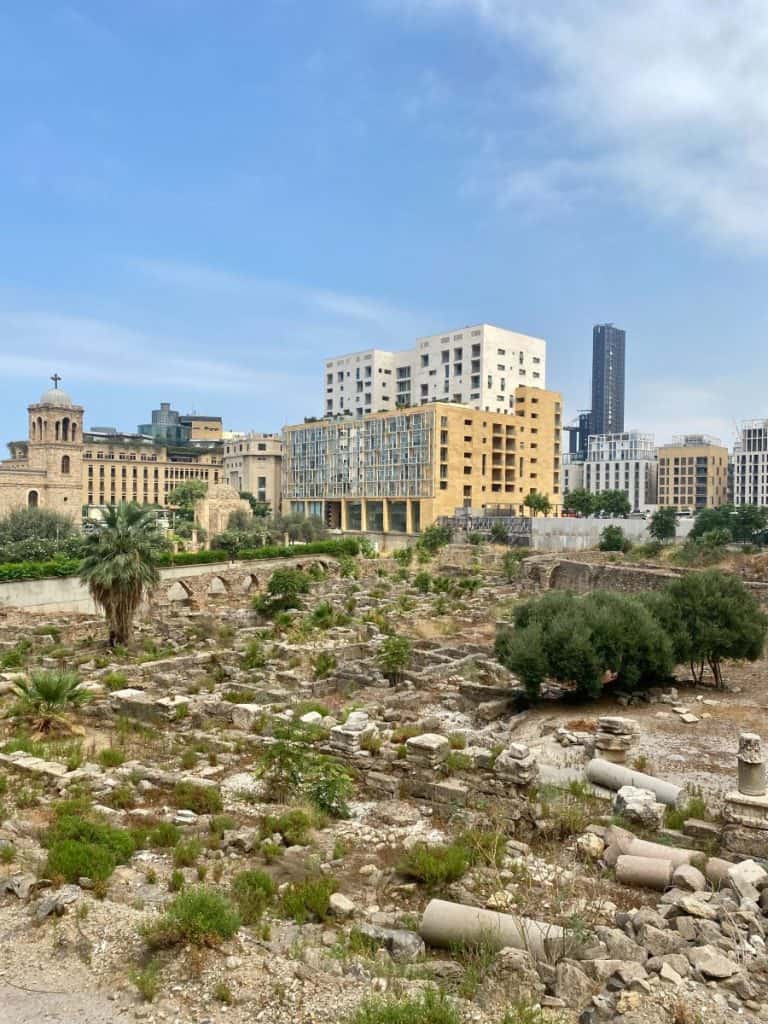
The Roman Forum in Beirut, also known as the “Berytus Roman Forum,” is an ancient archaeological site that dates back to Roman times.
It was actually discovered in 1994, during the construction of parliamentary offices. Next to it, a massive hippodrome was discovered, which turned out to be one of the five biggest in the Eastern Mediterranean. Impressive, isn’t it?
5. See the Mohammad Al Amin Mosque
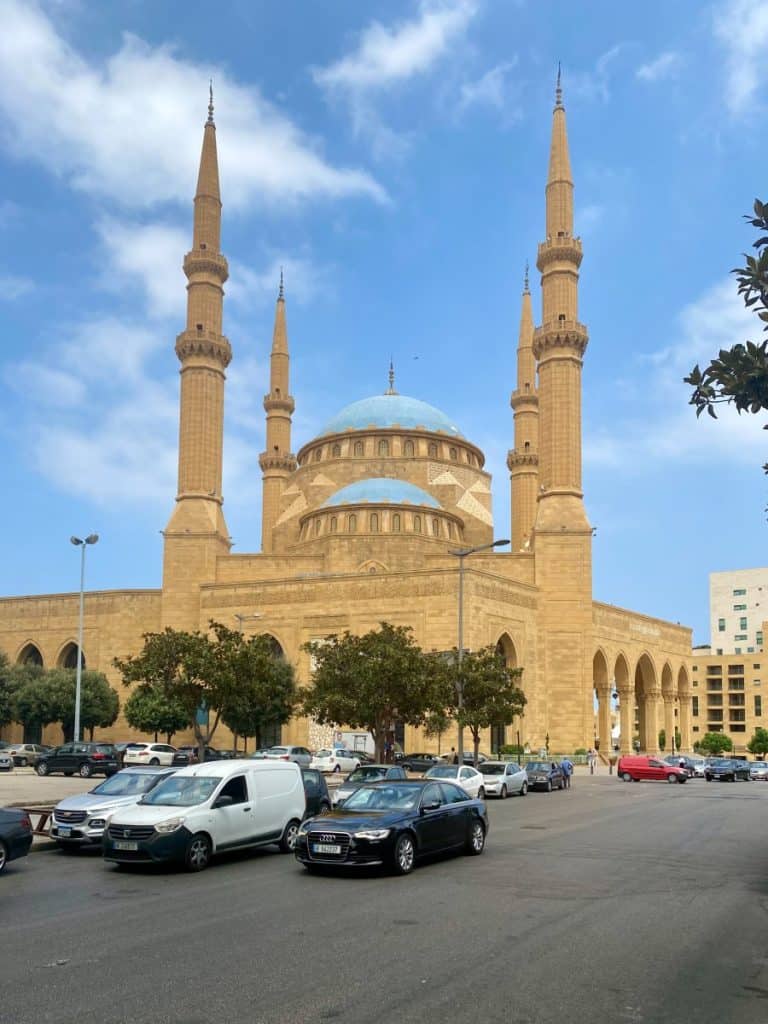
The Mohammad Al Amin Mosque is the biggest mosque in Lebanon and couldn’t be out of the Best Travel Guide for Beirut . Also known as the Blue Mosque, It’s famous for its impressive Ottoman-style architecture, featuring a large central dome and two minarets.
Next to it, you’ll find the mausoleum of the former prime minister Rafic Hariri, who played a big part in its construction but was assassinated in 2005, 3 years before the construction was completed.
The Blue Mosque is one of the most important religious sites in the city and is visible from many surrounding neighborhoods. It is something that surely cannot be missed when you travel to Beirut!
6. Go to the Saint George Maronite Cathedral
The Saint George Maronite Cathedral is a historic cathedral located next to the Blue Mosque. It is the seat of the Maronite Patriarchate and is famous for its majestic architecture and significance within the Maronite Christian community. It is also proof of the harmonic co-existence between the Muslim and Christian communities in Beirut.
7. Marvel Through Downtown Beirut
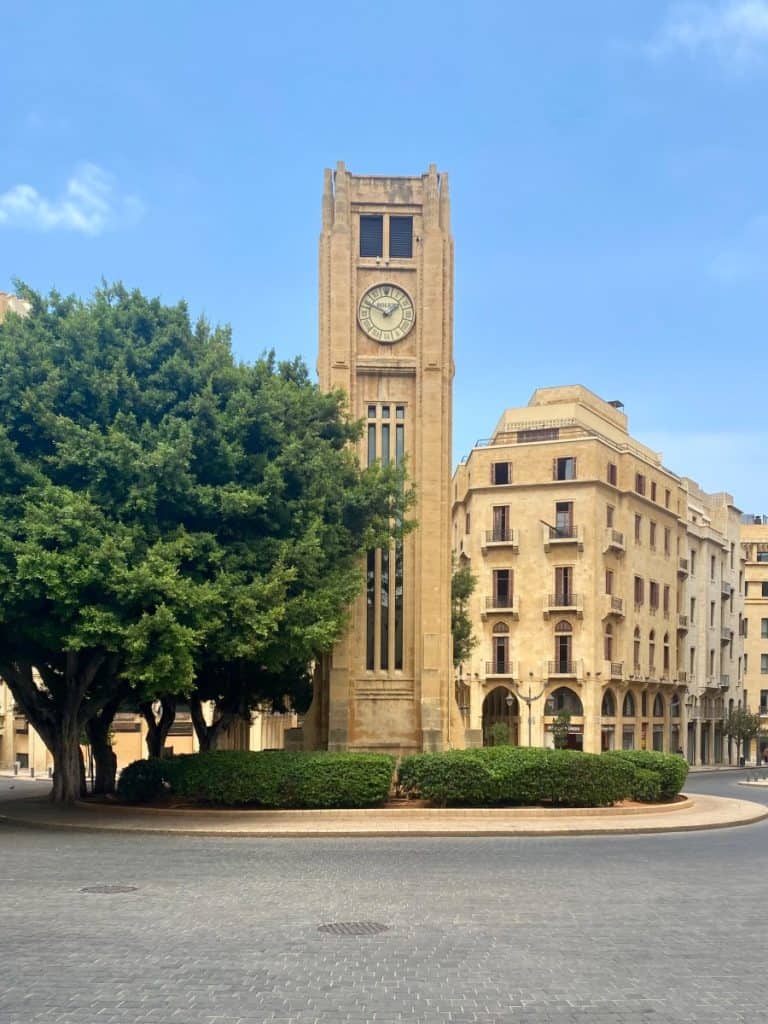
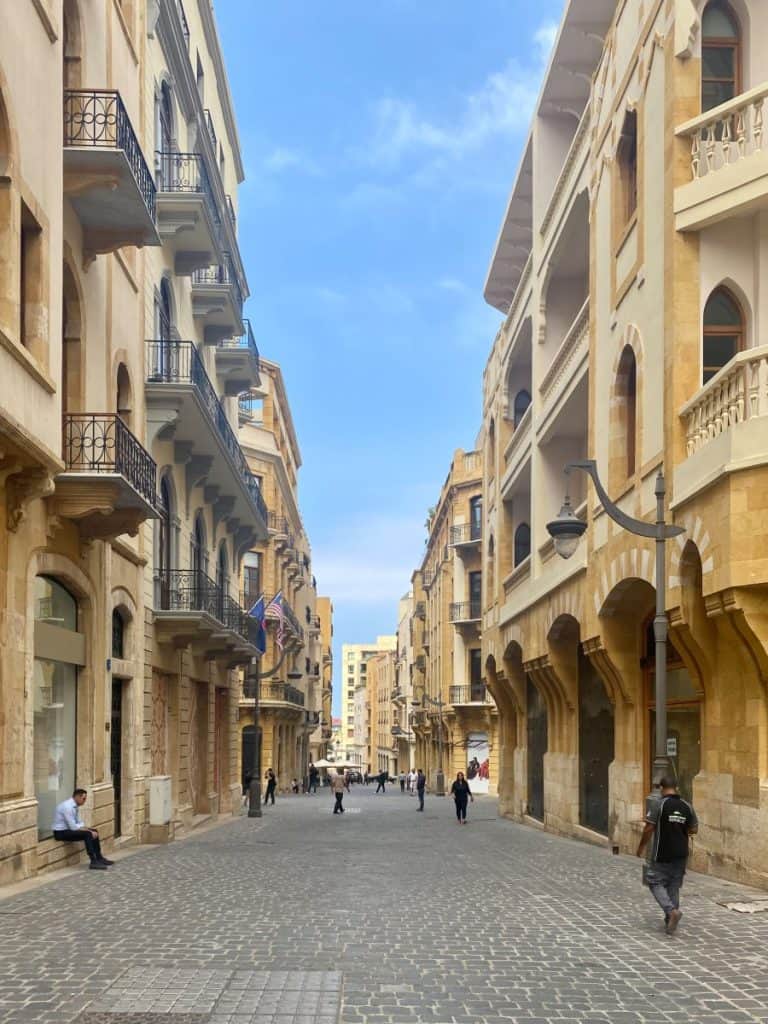
Downtown Beirut is the city’s central district. What was once a vibrant area with a mix of modern and historic buildings, shops, restaurants, and cultural attractions is now called “The Silent City.”
The recent financial crisis caused most of the shops to close, leaving this place empty. While walking there you’ll not hear any sounds, thus the name it got. It is a really interesting, calming, and quite spooky experience.
The streets are paved and no cars are allowed to pass. The most interesting fact is that there is a building that belongs to the country of Italy!
8. Visit the National Museum of Beirut
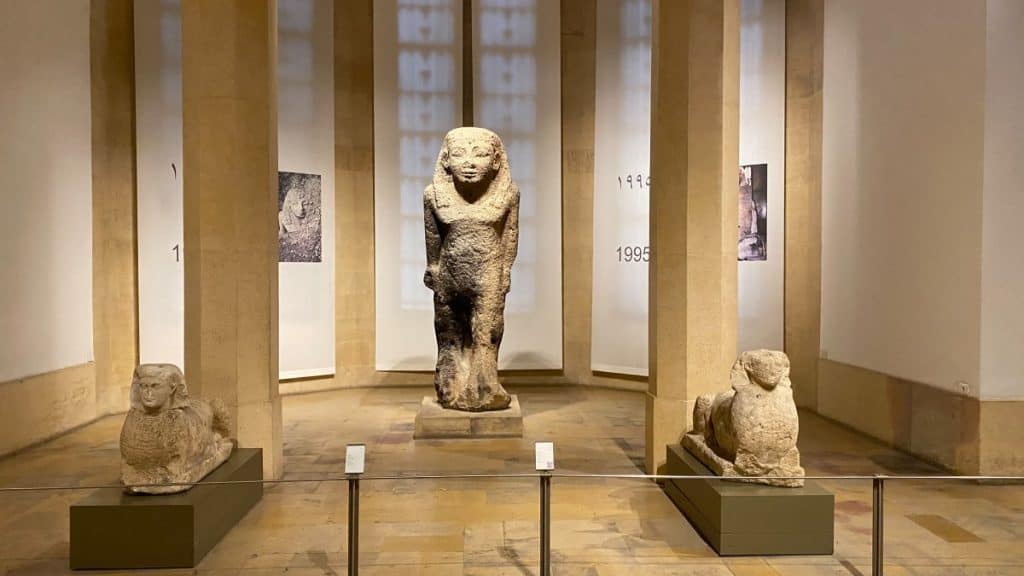
The National Museum of Beirut is a time capsule of Lebanon’s history. This modern museum is home to a fascinating collection of artifacts from Lebanon’s history, including items from prehistoric, Phoenician, Roman, and Islamic periods, all telling the story of the country’s rich past.
I really enjoyed my time in the museum. In fact, i could spend hours exploring and learning about the history of every single artifacts. My favorite one would definitely be the room with the sarcophagusses. The museum overall was a hit and that’s why it gets its spot in the Best Travel Guide for Beirut!
9. See the Mineral Museum
The Mineral Museum is located on the American University of Beirut (AUB) campus. It houses an extensive collection of minerals, gems, and fossils from Lebanon and around the world. It serves as an educational and research resource for geology enthusiasts and students and is an excellent (and alternative) attraction to visit when you travel to Beirut!
10. Go to the Beirut Explosion Memorial
The Beirut explosion, occurring on August 4, 2020, was a catastrophic event that sent shockwaves through Lebanon’s capital.
Triggered by the improper storage of a massive quantity of ammonium nitrate at the Port of Beirut, the blast unleashed an immense wave of destruction. The explosion not only devastated the port area but also wreaked havoc on surrounding neighborhoods, leaving a trail of death, injuries, and immense damage to buildings and infrastructure.
Just outside the port now stands a statue made of metals from the explosion. While you cannot enter the port, you can still se the destruction in the nearby buildings.
What are the hidden gems in Beirut that tourists often miss?
One hidden gem that tourists often miss in Beirut is the Sursock Museum. This privately-owned museum is tucked away in the historic Sursock Street and houses an impressive collection of contemporary and modern art. The museum itself is a beautiful blend of Lebanese and Venetian architecture, making it a visual treat in itself.
The neighborhood of Gemmayzeh is another often overlooked spot. This area is known for its traditional Lebanese architecture, vibrant street art, and bustling cafes. Walking through the narrow lanes of Gemmayzeh, you can get a glimpse of Beirut’s old-world charm and vibrant culture.
The Horsh Beirut, also known as Beirut’s Pine Forest, is the largest park in the city and a great place to escape the hustle and bustle. It’s a perfect spot for picnics, leisurely walks, or just to relax and enjoy the greenery.
Lastly, the Armenian neighborhood of Bourj Hammoud is a must-visit. Known for its bustling markets, delicious street food, and vibrant culture, this area offers a unique blend of Lebanese and Armenian influences. It’s a great place to shop for unique souvenirs and try some traditional Armenian dishes.
What are the best shopping spots in Beirut?
Do you want to do more just wondering around in Lebanon’s capital? Maybe you want to do some local (and not only) shopping? The Best Travel Guide for Beirut is again here for you!
1. Embark on a Shopping Spree at Beirut Souks
Prepare yourself for a dazzling mix of the modern and traditional as you dive into the vast array of shops that the Beirut Souks offer to every tourist. Nestled in the city center, these beautiful, modernly designed Souks are representative of Beirut’s rebirth. They are not only a shopping haven but also a symbol of resilience and growth.
Your visit to Beirut would be incomplete without the purchase of traditional Lebanese items like handmade crafts, aromatic spices, or intricate jewelry. Thankfully, Beirut Souks offer all that and much more. From high-end fashion brands to nostalgic bookshops, this place encapsulates the wide-ranging tastes of locals as well as tourists.
2. Navigate the Chic Boutiques in Saifi Village
An absolute paradise for those who find solace in retail therapy, Saifi Village beckons with a magnetic allure. It’s not just a shopping destination but also an art lover’s haven and a gourmet seeker’s delight. Imagine strolling down these quaint streets, the boutiques inviting you in with their tastefully curated window displays, each store a veritable showcase of Lebanon’s thriving arts and fashion scene.
Featuring an ensemble of local design talents, Saifi Village boasts chic boutiques where you will find clothing, accessories, and homewares crafted to perfection. Brands like Green & Glam and Debi.R will enchant you with their range of eco-friendly apparel and artisan jewellery, respectively.
Local designer Sarah’s Bag features fashion-forward handbags embellished with intricate and delicate beadwork, while Nada G‘s quirky and elegant jewellery pieces are absolute must-haves.
But shopping here isn’t limited to clothing and accessories alone. The world-renowned Designers & Friends store is a treasure trove of unique home décor items, custom-designed furniture, eye-grabbing art pieces, and carefully selected antiques. Each of these beautifully designed pieces reflect the Lebanese aesthetic and imaginative spirit.
3. Be a local at Sunday’s Farmer’s Market
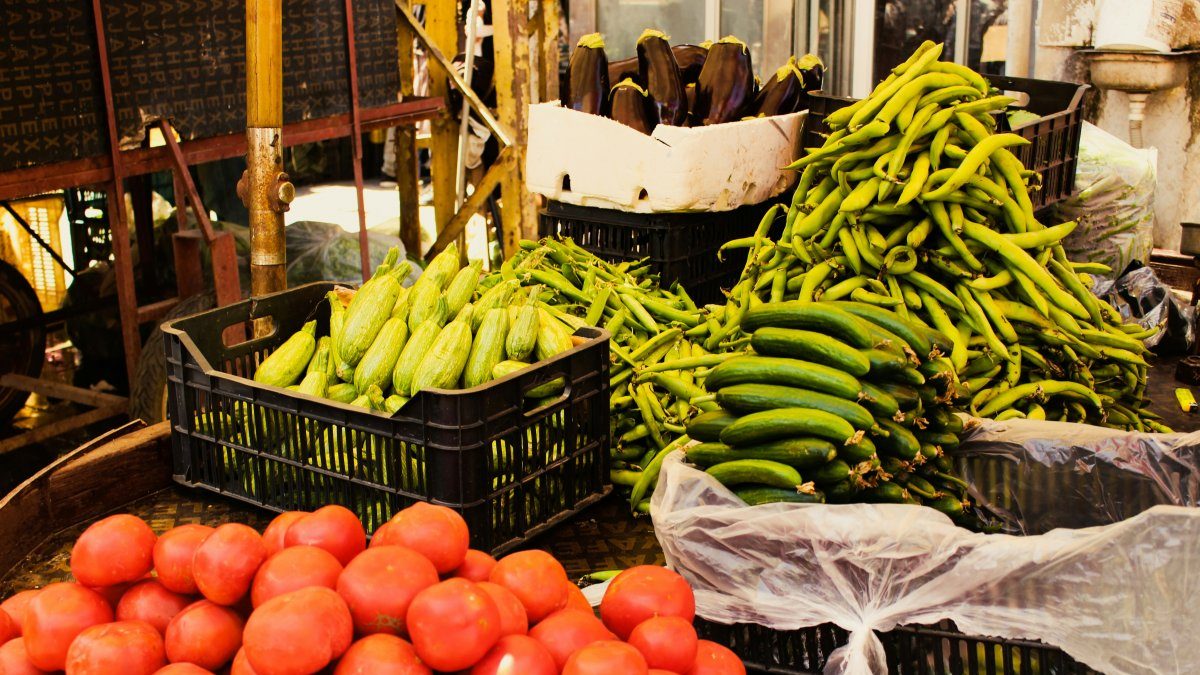
If you’re a locavore or simply appreciate the farm-to-table concept, Sunday’s Farmer’s Market in Beirut Souks is a must-visit. This vibrant space hums with fresh local produce and handmade foodstuffs, giving you a taste of Lebanon’s diverse and delicious palate.
The stalls run by local farmers brim with a colorful array of fruits, vegetables, herbs, and spices waiting to tingle your senses. Not only can you pick up the freshest produce straight from the farms, but you also get to meet the people behind it. Engage with them in conversation and you will find yourself enriched with knowledge about Lebanon’s farming practices and ingredients.
But the Farmer’s Market goes much beyond the daily bread. Think fresh and flavored olive oils, organic wines, artisanal cheeses, homemade conserves, and an array of local delicacies that are sure to delight the foodie in you. It’s a great way to fill your picnic baskets with goodies if you’re planning an outing, or simply to get your hands on unique, high-quality ingredients for home cooking.
Remember, the Farmer’s Market is held only on Sundays, from early morning till noon. To enjoy the full spread, it’s recommended that you arrive early in the day.
4. Stroll Down the Hamra Street for Exclusive Shopping
Stepping into Hamra Street, you’ll find yourself in the heart of a bustling city, with its fascinating blend of history and a modern shopping metropolis. With beautifully preserved French buildings lining the street, it’s an experience you won’t easily forget. Take a couple of hours, a day, or even an entire weekend to lose yourself in this unique shopping quarter.
This vibrant stretch in Beirut is legendary for its variety and vibrancy, offering everything from high-end boutiques to streetwear stores, and interspersed with quirky, eclectic shops. Traditional Middle Eastern garments, handcrafted jewelry, and luxury fashion brands – you’ll find it all here along with some of the city’s best bookshops, offering a delightful selection of local and international literature.
5. Explore Handmade Crafts at Artisans Du Liban
At Artisan Du Liban, you’ll find yourself immersed in an artistic haven where authentic Lebanese craftsmanship shines through. Step inside and let the aromas of cedarwood carvings and the sight of vibrant tapestries take you on a creative journey into Lebanon’s rich cultural heritage.
You’ll discover an array of handmade goods that truly capture the Lebanese spirit. From intricate jewelry, hand-embroidered clothing, ceramic bowls, to beautifully crafted blown glass items, everything on display is made by talented local artisans. Many of these pieces are one-of-a-kind, carrying an essence that is undeniably unique and deeply rooted in Lebanese tradition.
Don’t hesitate to chat with the personable shopkeepers, they are often very knowledgeable and can provide interesting insights into the creation process of each piece. If you’re looking for souvenirs to take back home or gifts for loved ones, Artisan Du Liban offers an extraordinary shopping experience where every item tells a story, ensuring a memento that will be cherished for years to come.
What are the best beaches in Beirut Lebanon?
1. Ramlet El Baida Beach
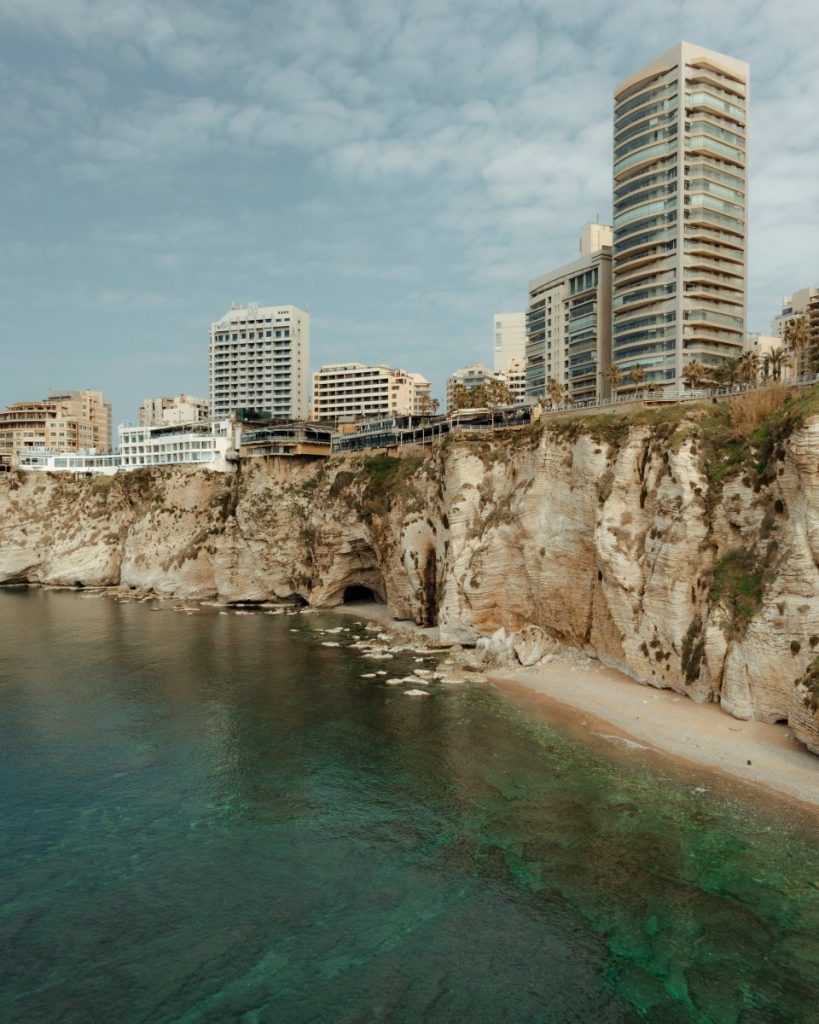
Imagine lounging on the only public sandy beach in Beirut – Ramlet El Baida. It is a popular destination for both locals and tourists, offering a serene escape from the bustling city life.
Located in the southwestern part of the city, the beach is known for its wide sandy shore and clear waters. It’s a great spot for sunbathing, swimming, and picnicking. Despite its urban location, the beach maintains a calm and relaxing atmosphere.
Nearby, there are several cafes and restaurants where visitors can enjoy traditional Lebanese cuisine while taking in the beautiful seaside views. The beach is also within walking distance to some of Beirut’s top attractions, such as the Pigeon Rocks and the Corniche promenade.
However, it’s important to note that the beach’s cleanliness can vary depending on the season and recent weather conditions. It’s always recommended to check local reports before planning a visit. Despite these occasional issues, Ramlet El Baida remains a beloved spot in Beirut, embodying the city’s resilience and vibrant spirit.
2. Bourj Hammoud Beach
Stretches of pebble and stone, the Bourj Hammoud Beach, located in the northern part of Beirut, provides a unique seaside experience away from the bustling city center.
While it’s not a conventional beach destination, Bourj Hammoud Beach is a significant part of Beirut’s cultural and historical fabric. It’s situated in a district known for its Armenian heritage, offering a unique blend of cultures, cuisines, and traditions.
However, it’s important to note that Bourj Hammoud Beach is not ideal for swimming due to pollution issues. The beach is more of an urban space where the city meets the sea, rather than a spot for sunbathing or water sports.
3. Saint-George Yacht Club & Marina
Looking for a luxury beach experience? Look no further than the Saint-George Yacht Club & Marina. With sparkling waters and a variety of water sports, your beach day here will be anything but ordinary.
The marina is home to a variety of luxury yachts and boats, offering a picturesque view of the sea. It’s a haven for boating enthusiasts, with top-notch facilities for docking, maintenance, and sailing. The marina also hosts several boating events throughout the year, attracting sailors from around the world.
Beyond its boating facilities, the Saint-George Yacht Club is a social hub. It features a stylish clubhouse with a range of amenities. These include a restaurant serving exquisite Lebanese and international cuisine, a bar offering a wide selection of beverages, and a swimming pool overlooking the sea.
The club also boasts a fitness center and a spa, providing a range of wellness services. Members can enjoy yoga classes, personal training sessions, and a variety of spa treatments. The club’s facilities are designed to provide a luxurious and relaxing environment.
What are the best day trips from Beirut, Lebanon?
1. Visit Byblos City
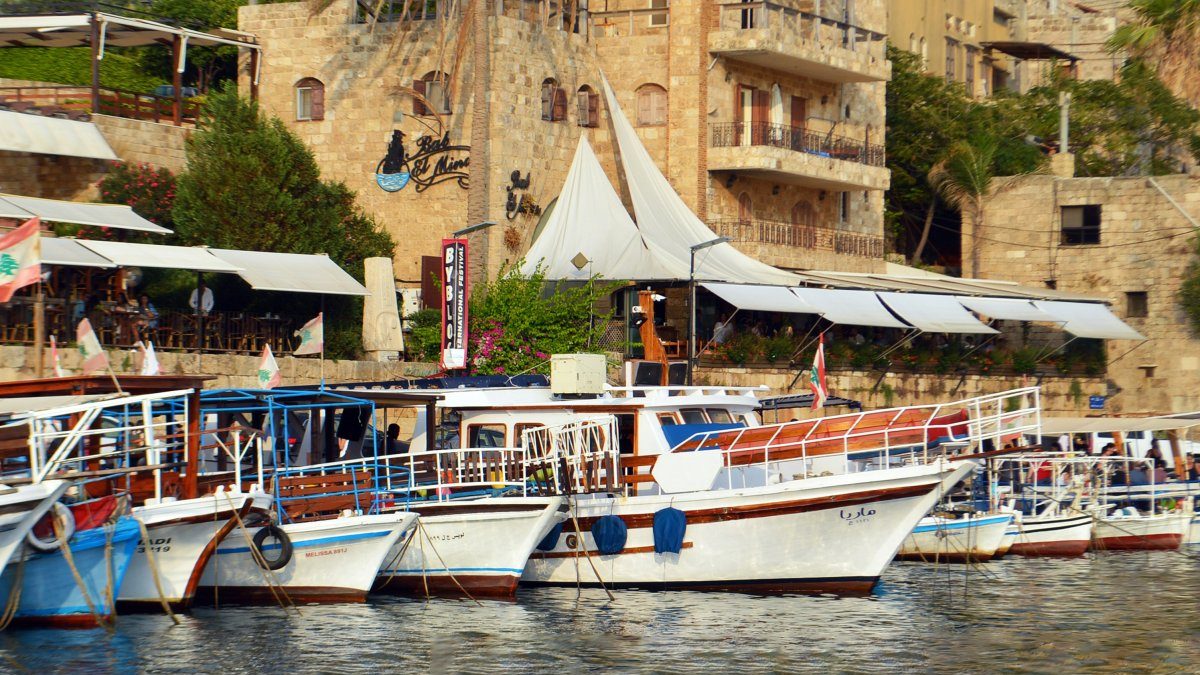
When looking for the best day trips from Beirut, Byblos city tops the list. Known to be one of the oldest continuously inhabited cities in the world, it beckons with its fascinating historical sites, fragrant orange groves, and quaint harbor. Don’t miss the ancient Phoenician temples and the Byblos castle while you’re there.
2. Trip to Baalbek
An expedition to the city of Baalbek is ideal for history enthusiasts. A UNESCO World Heritage site, it boasts imposing Roman temples that will leave you spellbound. The Temple of Jupiter and the Temple of Bacchus are marvels of Roman architecture and an absolute must-see.
3. Hiking in Qadisha Valley
For the adventurous spirits, the Qadisha Valley provides the perfect setting for a heart-pumping active day. The valley is dotted with centuries-old monasteries and hermitages, making the hike educational as well as refreshing. Be sure to pack good walking shoes and be prepared to be blown away by the stunning views.
4. Explore the Jeita Grotto
The Jeita Grotto, situated 20 kilometers north of Beirut, showcases a fascinating world of stalactites, stalagmites, caverns, and galleries. A boat ride on the underground river within the grotto adds to the uniqueness of the experience. This place is a testament to the natural beauty of Lebanon.
Are there any safety tips for traveling in Beirut, Lebanon?
1. Key Safety Tips While Touring Beirut
When touring Beirut, it’s crucial to prioritize your safety at all times. Like with any other city in the world, ensuring you’re well-prepared and aware of your surroundings is key to a fulfilling travel experience.
2. Local Laws and Customs
For a smooth journey, it’s advisable to familiarize yourself with Lebanon’s local customs and laws. For instance, it’s considered disrespectful to wear revealing clothes at religious places. Always respect the local culture to avoid uncomfortable situations.
3. Stay Vigilant in Crowded Places
Crowded areas can sometimes be a hotbed for petty crimes such as pickpocketing. Always keep an eye on your belongings and avoid displaying expensive items openly.
4. Avoiding Areas of Political Unrest
While Beirut is generally safe for tourists, occasional political unrest can stir tension, especially in certain areas. Always stay updated with local news and avoid areas of ongoing protests or demonstrations.
5. Health Precautions
Always ensure that your travel insurance covers medical expenses and have emergency numbers at hand. It’s also recommended to avoid tap water and stick to bottled water for drinking and brushing teeth.
Final Thoughts
It is true that the recent crisis has had a huge toll in the city’s infrastructure, and the money exchange struggle, the power cuts, and the lack of public transportation options will not make life easy for a tourist. However, Lebanon’s vibrant capital is still a place rich in culture and heritage.
From the stunning Pigeon Rocks to the bustling streets of Hamra and the vibrant markets, the Best travel Guide for Beirut proves that this is a city worth exploring. Its delicious cuisine and friendly locals will make sure you have an amazing trip. So a few minor inconveniences are not enough to undermine the many great experiences you can enjoy when you travel to Beirut.


